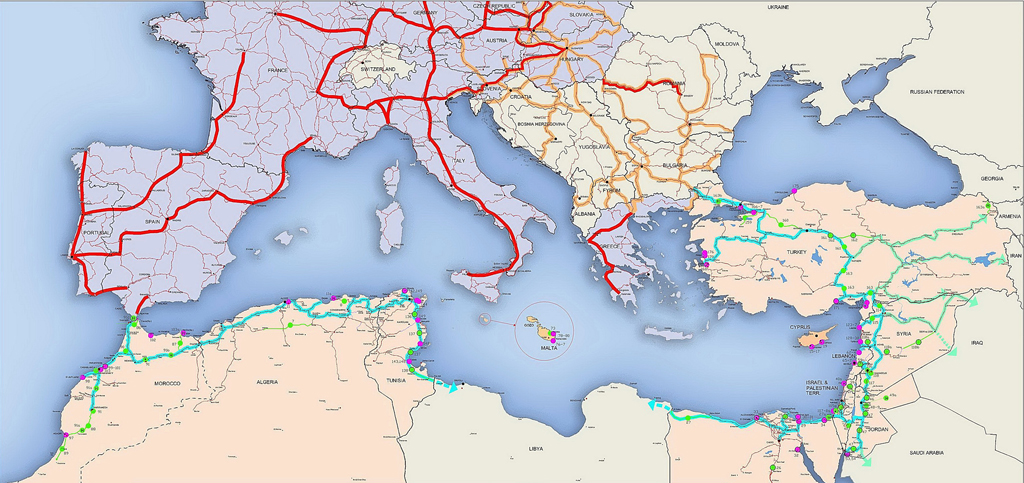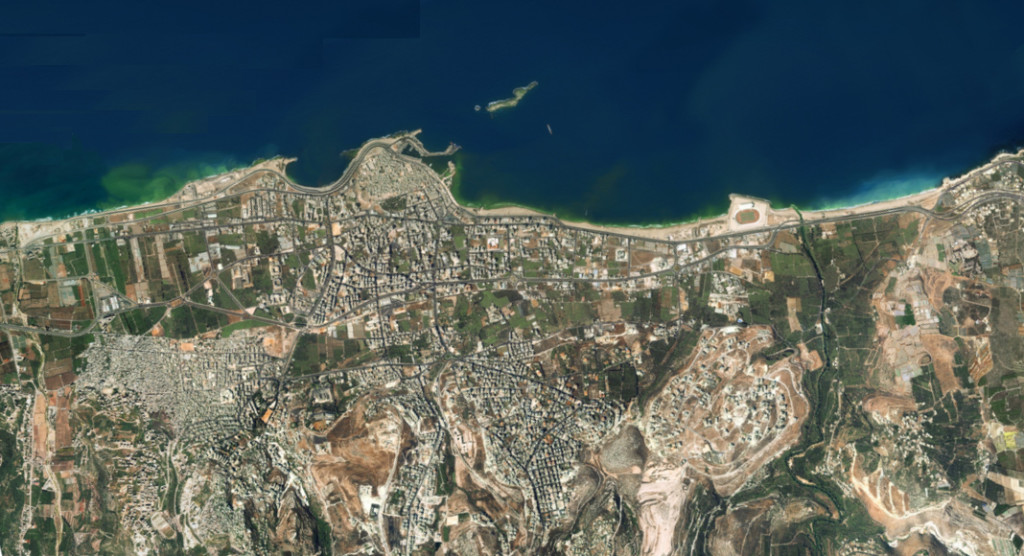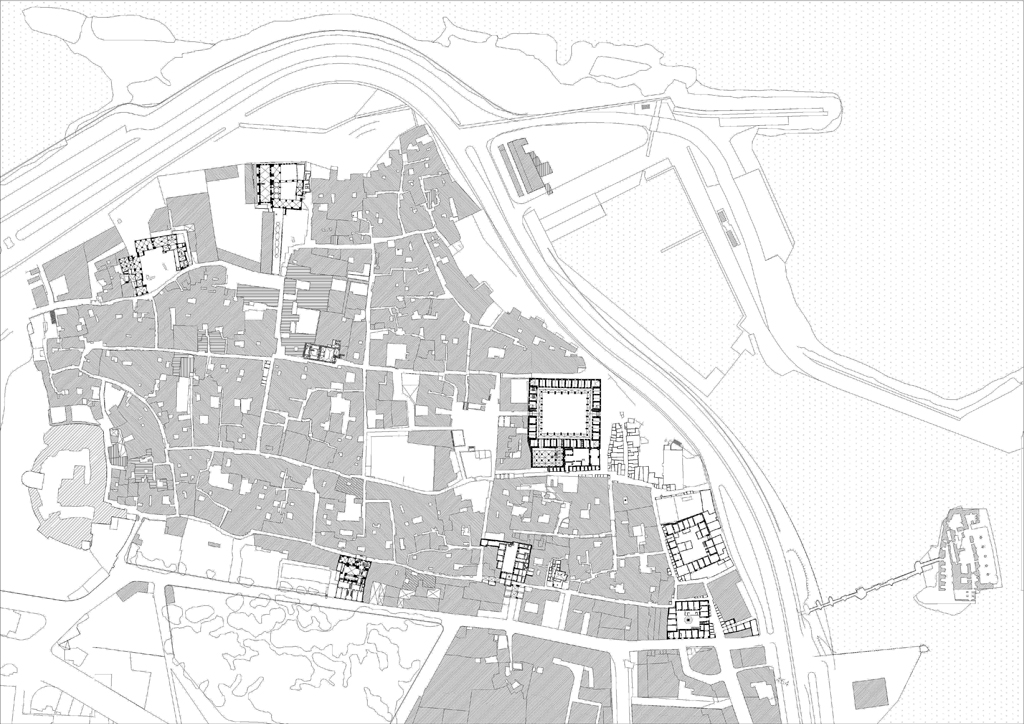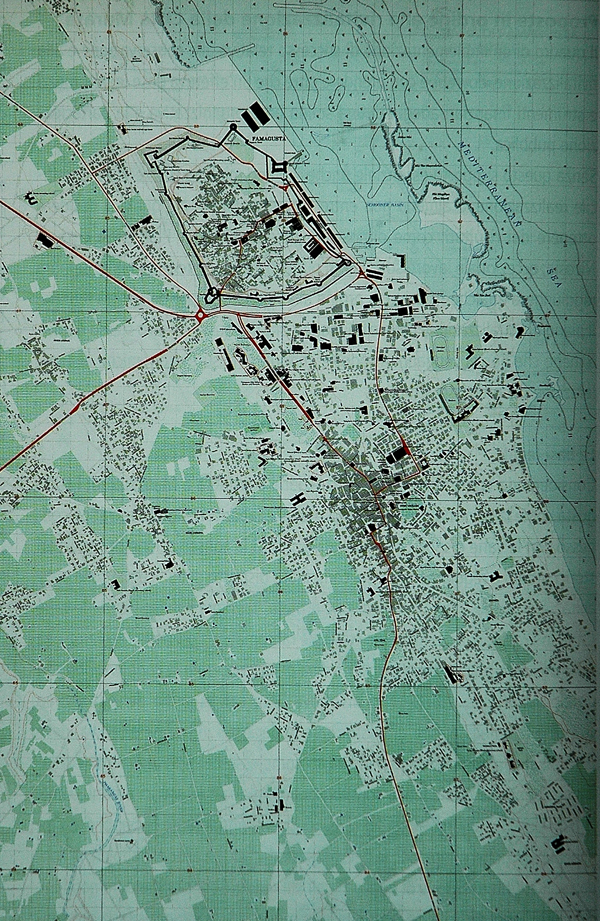Mediterranean medium sized city-ports. General approach
The territorial understanding is a complex and exciting task, especially in remarkable historical load regions. In any littoral scenario, and specifically as regards the Mediterranean, you cannot separate the mainland from maritime realities. Both have woven a system of cities and ports which represented the basis of a common culture. This base meant the starting point of a territorial balance that has remained long. A progressive deterioration of these relationships has defined a transitional current situation.
Talking about Mediterranean sea, we are witnessing a gradual process of regional coastal population concentration, to be completed in its southern half within the next fifteen years. The global average rating of 50% of the population of urban character rises to 75% in the countries of the Mediterranean basin [1]. The currently average population density in this sea coast is more 2.6 times than the average of the Mediterranean countries (fig.1) .
 Fig.1 Population distribution on 1995 ( Houpin S.,2010, “Urban mobility and sustainable development in the Mediterranean. Regional diagnostic outlook Plan Bleu”, Sophia Antipolis ).
Fig.1 Population distribution on 1995 ( Houpin S.,2010, “Urban mobility and sustainable development in the Mediterranean. Regional diagnostic outlook Plan Bleu”, Sophia Antipolis ).
Pressure over Mediterranean is obvious. Although the Mediterranean constitutes 0.7% of sea surface area, it accounts for 30% of global shipping and between 20% and 25% of oil traffic. It is one of the world’s leading transit areas. Transit accounts for 40% of Mediterranean traffic [2].
A major territorial imbalance have been triggered by increasing maritime traffic [3] and more specifically the respective specializations, along with decreased piscatorial activity (fig.2).Tourism, container port traffic and limited fishing are the triad for this situation.
 Fig.2 Euromediterranean Transport Project. European Commission (2005). Initial screened projects and proposed projects rails and ports.
Fig.2 Euromediterranean Transport Project. European Commission (2005). Initial screened projects and proposed projects rails and ports.
The current dynamic is set on two levels. For one, greater scale city-ports establish territorial competition among them with their own resources. Its control may be as necessary as important [4]. The struggle to monopolize larger market shares may lead to situations difficult to sustain in other less favorable socio-economic scenarios. In fact this situation is already suffering in other sectors, to have been a voracious urbanization in the northern Mediterranean. Furthermore, we are witnessing a process of degradation of small and medium scale city-ports that fail to interact with any of the topics generating economic activity along the coast [5].
The concept of a geo-strategic unit as EUROMED should help articulate as best this competition, especially from a new territorial perspective, not only from a European one. The reconstruction of the Euro-Mediterranean spirit has undergone uncountless vicissitudes. The Barcelona process, criticized by some, [6] excited through a stage where the Union for the Mediterranean [7] (UfM) seems to rise from the early season ashes. The major activity of its Transport and Urban Development Division [8] prior assessment of the work to be called to the various programs financed by European cooperation is vital to understand the many possibilities that this new geostrategic alchemy can bring.
The Arab spring need of funds to help support certain structures. The city and the port, as symbols of the UfM’s Division, are called to engage in greater and getting so more opportunities to centralize efforts in that direction. According to Rosa Anna La Rocca, [9] motorways of the sea are not just a matter of water, but of land, sometimes a lot of land.
The complex view of the problem should lead to new solutions to stop exporting to South Mediterranean development models tested so long as failures. This vision must take into account complex Mediterranean urban whereas, which is important for their absolute and relative need of solutions. And they probably will not come from disproportionate action in the same points, but in a scattered and controlled action in the gaps still existing.
This regional approach should not forget the lower levels, ie, the view from the port city, cause and origin of the Mediterranean culture. It should also be the source of a balanced territorial recovery.
The small and intermediate scale city-port attends a process of obsolescence of particular concern when family character / individual tourism does not appear. We focus on Saïda (fig.3) and Famagusta (fig.4), in the eastern Mediterranean, where there are other similar situations.
 Fig.3 Aerial view of Saïda District.
Fig.3 Aerial view of Saïda District.
Fishing activity almost disappeared and freights were delocalized to greater scale ports due to commercial or political reasons .These circumstances provoke an opportunity to rethink the new features of the port city. In both cities, interposition of the historical area between the port and the new city generates both similar responses: the historic center attends a rehabilitation process reduced to partial touristic paths, economic base of this area of ??town. Areas not integrated into these paths are attending an uncertain degradation process.
Presence of Palestinian families seems partially rebalance this situation in Saïda, especially next to the inland castle. The whole city is dismembered in terms of the various Palestinian or Lebanese settlements, throughout the entire territory. By contrast, no revitalization of the intramural northern area is perceptible in Famagusta. The absence of gates in this area and it is low accessibility help in this regard.
Fig.4 Famagusta District Map (Army Map Service (KC) Corp of Engineers US Army Washington DC, 1968) .
The relationship between city and port in Saïda has been altered by the new high way that separates both areas and has been a significant change in the morphology of the urban water-front. Built destructed elements marked the start of a process of gentrification around the San Jorge Castle (fig.5) .
The port-city relationship is strongly conditioned by the own Famagusta urban morphology. Really the historic city is limited by the existence of the surrounding walls and the formal and functional separation between port and city (fig.6). The political becoming area in turn have caused the presence of a “slum” as in the case of Varosha, a symbol of the persistent conflict in the seventies, which has deeply the existing urban fabric of the city, in its southern sector [10].
 Fig.5 Historical City-port relation in Saïda. (© José Manuel Pagés Madrigal, 2013)
Fig.5 Historical City-port relation in Saïda. (© José Manuel Pagés Madrigal, 2013)
Commercial activity is an important element for supporting for the reestablishment of relations between the port, city and its territory. The Saïda’s souk acts as the backbone of the city, as a link between the historical and the contemporary city. Famagusta market, close to the mosque-cathedral, went on to play other roles, although the axis Limassol – Sea gate. Sea market activity continues to characterize intramural area, more vacationed to tourism.
The potentialities of Saïda and Famagusta are inevitably related to their waterfront or coast-line. In the Lebanese city expectations are focused on southern sector, with a new marina as conventional model. In the case of the Cypriot city, development pressure seems to be much smaller but more signals are detected pre-urban activity with the new municipal auditorium interposition between the current city and the archaeological site of Salamis, in the northern sector.
The university sector can play an important role in urban development. The opening of the Eastern Mediterranean University in Famagusta in 1979 emerged as a dynamic element till now [11] (fig.7). The economical involvement of this institution in the Municipal Auditorium building close to northern beaches is a sign of commitment to urban regeneration territorial relations between city and port. The presence of universities in Saïda is not so visible, but it can be a regeneration factor in the future.
Any considerations around both cities, except their specificities, can serve as the first reference to a discussion that allows developing common strategies to a widespread problem. Reflection developed within the WaRe project [12] can be used for its generalization in the Mediterranean basin [13].
The Euro-Mediterranean identity necessarily involves port network recovery. [14] And this network should encourage dual scale synthesis that look twice the territory referred to above: the globally competitive ports [15], and ports of medium and small-scale territorial real engines from immemorial times.
 Fig.6 City – port relation in Famagusta.
Fig.6 City – port relation in Famagusta.
We ask ourselves what is actually today the sea. We cannot live only in the past. This concept is to reinvent and redefine the relationship between city and port. The role of port authorities is emptied on these scales, but jurisdictional disputes between port and city are still valid.
Of this balance, double those eyes, those aquatic and terrestrial issues, depends much of the future of this region.
Head image: Arial picture of Famagusta. Marked area is the Eastern Mediterranean University. Aerial view (General Direction of Tourism North Cyprus Republic).
Medi Terraneum البحر الأبيض المتوسط al-Baḥr al-Mutawāsiṭ
Ciudades portuarias de media escala en el Mediterráneo. Contexto general
La comprensión territorial es una tarea compleja y apasionante, en especial en regiones con una notable carga histórica. En cualquier escenario litoral, y específicamente en lo que al Mediterráneo se refiere, no se pueden separar las realidades marítimas de tierra firme. Ambas han ido tejiendo un sistema de ciudades y puertos que supusieron la base de una cultura común. Esta base supuso el punto de partida de un equilibrio territorial que se ha mantenido mucho tiempo. Un progresivo deterioro de estas relaciones ha definido una situación actual de transición.
Se asiste a un proceso progresivo de concentración poblacional litoral regional, que se completará en su mitad sur en los próximos quince años. La valoración media mundial del 50% de la población de carácter urbano sube hasta el 75% en los países de la cuenca mediterránea [1] . Actualmente la media de la densidad de población litoral en este mar es más de 2,6 veces superior a la media de los países mediterráneos.Fig.1 Population distribution on 1995 ( Houpin S.,2010, “Urban mobility and sustainable development in the Mediterranean. Regional diagnostic outlook Plan Bleu”, Sophia Antipolis ).
El incremento de la escala y densidad del tráfico marítimo [2] y más concretamente las respectivas especializaciones, junto al descenso de la actividad piscatoria han desencadenado un importante desequilibrio territorial. Turismo, tráfico de contenedores y una menor pesca constituyen el trinomio sobre el que se asienta esta situación.Fig.2 Euromediterranean Transport Project. European Commission (2005). Initial screened projects and proposed projects rails and ports.
La dinámica actual se establece en dos niveles. Por un lado, las ciudades- puerto de mayor escala establecen una competencia territorial con recursos propios cuyo control puede ser tan necesario como importante [3]. La lucha por acaparar mayores cuotas de mercado podrá llevar a situaciones difícilmente sostenibles en otros escenarios socio económicos menos favorables. De hecho esta situación ya se está sufriendo en otros sectores, al haberse producido una urbanización voraz en el Mediterráneo norte. Por otro, se asiste a un proceso de degradación de las ciudades-puerto de la pequeña y media escala que no consiguen relacionarse con alguno de los tópicos generadores de actividad económica del litoral.
El concepto de una unidad geo-estratégica como es EUROMED debe ayudar a articular del mejor modo esta competencia, en especial desde una nueva perspectiva territorial, no sólo desde una perspectiva europea. La reconstrucción del espíritu euro-mediterráneo ha pasado por innumerables vicisitudes. El proceso de Barcelona, criticado por algunos [4], vive una etapa ilusionada donde la Unión para el Mediterráneo [5] (UfM) parece renacer de sus tempraneras cenizas. La actividad importante de la Secretaria de Transportes y Desarrollo Urbano de esta Institución [6], la valoración previa de los trabajos que deben ser llamados a financiarse por los diversos programas europeos de cooperación, resulta vital para entender las múltiples posibilidades que esta nueva alquimia geoestratégica puede deparar.
La primavera árabe necesita de fondos que ayuden a reforzar determinadas estructuras. La ciudad y el puerto, como símbolos de este secretariado de la UfM, están llamados a relacionarse en mayor modo y surgen oportunidades para centralizar los esfuerzos en ese sentido. En palabras de Rosa Anna La Rocca, [7] las autopistas del mar no son solo una cuestión de agua, sino de tierra, en ocasiones de mucha tierra.
La visión compleja del problema debe llevar a nuevas soluciones que permitan dejar de exportar al Mediterráneo Sur modelos de desarrollo tan largamente probados como fracasados. Esta visión compleja deberá tener en cuenta que el fenómeno urbano mediterráneo, siendo importante por sus valores absolutos y relativos necesita de soluciones. Y éstas, probablemente no vendrán de una acción desmesurada en estos mismos puntos, sino en una acción dispersa y controlada en los vacios, aún existentes.
Esta perspectiva regional del problema no debe olvidar las escalas inferiores, es decir, la mirada desde la ciudad-puerto, causa y origen de la cultura mediterránea. También deberá ser el origen de una reactivación territorial equilibrada.
Las ciudades-puerto de escala pequeña e intermedia asisten a un proceso de obsolescencia especialmente preocupante cuando el turismo de carácter familiar/individual no aparece. Nos centramos en Saïda y Famagusta, en el Mediterráneo oriental, donde se aprecian situaciones similares.Fig.3: Aerial view of Saïda District.
Una actividad piscatoria casi desaparecida y un tránsito de mercancías deslocalizado a puertos de mayor escala por razones comerciales o políticas abren una ventana de posibilidades para repensar las nuevas funciones de la ciudad-puerto. En ambas ciudades, la interposición de la ciudad histórica entre el puerto y la ciudad actual genera sendas respuestas similares: el centro histórico asiste a un proceso de rehabilitación parcial reducido a los recorridos de carácter turístico, base económica de este sector de ciudad. Las zonas que no se integran en este sector asisten a un proceso de degradación de incierto destino.
En el caso de Saïda la presencia de familias palestinas parece reequilibrar parcialmente esta situación, en especial en la zona próxima al castillo de tierra. El conjunto de la ciudad aparece desmembrado en función de los diversos asentamientos, palestinos o libaneses a lo largo de todo el territorio. Por el contrario, en Famagusta no es perceptible una posible revitalización del sector norte intramuros. La ausencia de puertas en esta zona y su menor accesibilidad ayudan en este sentido.
Fig.4: Famagusta District Map (Army Map Service (KC) Corp of Engineers US Army Washington DC, 1968.
La relación entre ciudad y puerto en Saïda se ha visto alterada por la nueva vía rápida que separa ambas zonas y que ha supuesto un importante cambio en la morfología del water-front urbano. La destrucción de algunos elementos edificados ha supuesto el inicio de un proceso de gentrificación, alrededor del castillo de San Jorge.
La estructura de esta relación está fuertemente condicionada en Famagusta por la propia morfología urbana Realmente la ciudad histórica está limitada por la existencia de las murallas en su integridad y por la propia separación formal y funcional entre puerto y ciudad. Los devenires políticos de la zona han provocado a su vez la presencia de un “slum” como es el caso de Varosha, uno de los símbolos persistentes del conflicto existente en los años setenta, que ha marcado profundamente la trama urbana actual de esta ciudad, en su sector sur [8] .Fig.5: Historical City-port relation in Saïda. (© José Manuel Pagés Madrigal, 2013)
La actividad mercantil supone un elemento importante de apoyo para la refundación de las relaciones entre la ciudad-puerto y su territorio. En Saïda el souk actúa como elemento vertebrador de la ciudad, como nexo entre la ciudad histórica y la ciudad contemporáneo. En Famagusta el propio edificio del mercado, vecino a la mezquita-catedral, pasó a desempeñar otras funciones, aunque el eje entre las puertas del Mar y de Limassol sigue caracterizando la actividad mercantil intramuros más dedicada al sector turístico.
Las potencialidades de Saïda y Famagusta están inevitablemente relacionadas con sus waterfront o coast-line. En la ciudad libanesa las expectativas se centran el sector sur en torno a una nueva marina según el modelo convencional. En el caso de la ciudad chipriota, la presión urbanística es mucho menor aunque se detectan señales de mayor actividad pre-urbana con interposición del nuevo auditorio municipal entre la ciudad actual y el sitio arqueológico de Salamina, en el sector norte.
El sector universitario puede jugar un importante papel en el desarrollo urbano. La inauguración de la Eastern Mediterranean University en Famagusta en 1979 se erigió en elemento dinamizador hasta la fecha [9]. La participación de esta Institución en la edificación del auditorio municipal en la zona costera es una señal de compromiso urbano-territorial con la regeneración de las relaciones entre ciudad y puerto. La presencia de instituciones universitarias en Saïda es continuada a lo largo de las últimas dos décadas.
Cualquiera de las consideraciones en torno a ambas ciudades, salvadas sus especificidades, pueden servir de primera referencia para una discusión que permita desarrollar estrategias comunes para un problema generalizado. La reflexión desarrollada dentro del proyecto WaRe [10] puede ser aprovechada para su generalización en la cuenca mediterránea [11] .
La identidad euro-mediterránea pasa necesariamente por la recuperación de la red portuaria [12] . Y esta red, debe propiciar la doble escala, síntesis de esa mirada doble al territorio antes referida: los puertos competitivos a escala global, [13] y los puertos de media y pequeña escala, verdaderos motores territoriales desde tiempos inmemoriales.Fig.6. City – port relation in Famagusta.
Nos preguntamos qué es en realidad hoy el mar. No podremos vivir exclusivamente del pasado. Es necesario reinventar este concepto y redefinir las relaciones entre ciudad y puerto. El papel de las autoridades portuarias se ha vaciado en estas escalas, pero los conflictos de competencia entre puerto y ciudad continúan vigentes.
De ese equilibrio, de esas dobles miradas, de esas cuestiones acuáticas y terrenales, depende buena parte del futuro de esta región. Head image: Arial picture of Famagusta. Marked area is the Eastern Mediterranean University. Aerial view (General Direction of Tourism North Cyprus Republic).
[1]https://www.planbleu.org/publications/4p_urbain_uk.pdf[2]https://www.worldshipping.org/about-the-industry/global-trade/top-50-world-container-ports[3] Tongzon, Jose, Heng, Wu: Port privatization, efficiency and competitiveness: Some empirical evidence from container ports (terminals) in Transportation Research Part A: Policy and Practice,vol.39, issue 5,2005. https://www.sciencedirect.com/science/article/pii/S096585640500025X Ducruet, César Lee, Sung-Woo(2006): Frontline soldiers of globalisation: Port–city evolution and regional competition in: GeoJournal, vol.67, issue,2, 2006. https://link.springer.com/article/10.1007%2Fs10708-006-9037-9?LI=true[4]https://www.fride.org/publication/653/the-end-of-the-euro-mediterranean-vision[5]https://www.ufmsecretariat.org/en/[6]https://www.ufmsecretariat.org/en/transport-and-urban-development/[7]https://www.tema.unina.it/index.php/tema/article/view/urn%3Anbn%3Ait%3Aunina-3505[8]https://www.documentingreality.com/forum/f236/abandoned-resort-varosha-quarter-famagusta-116664/https://sometimes-interesting.com/2011/07/19/abandoned-mediterranean-resort-varosha-quarter-in-famagusta-cypress/[9]Gazima?usa ?ehrinin Kentsel Geli?iminin Sürdürülebilirli?ine Yönelik Çözüm Önerileri[10]https://www.ware-project.net/[11]https://www.ware-project.net/index.php?option=com_content&view=article&id=32&Itemid=25[12]https://www.etcproceedings.org/paper/maritime-container-trades-in-the-mediterranean-area-pre-and-post-crisis-scenarhttps://www.planbleu.org/publications/urbsprawl.pdf
[13]https://www.ufmsecretariat.org/en/ufm-labelled-project-logismeta-to-contribute-to-the-creation-of-jobs-in-the-region-2/
